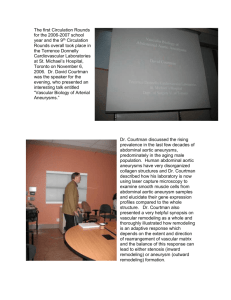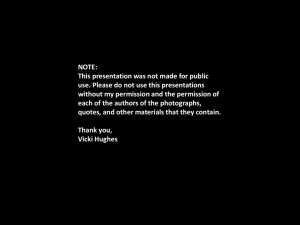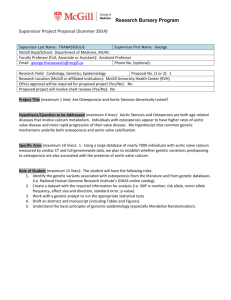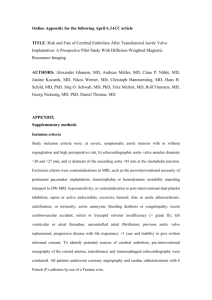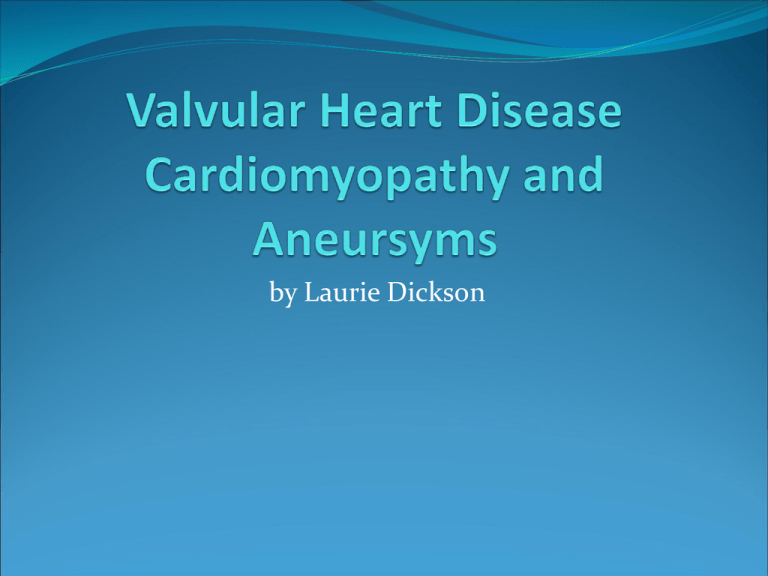
by Laurie Dickson
Valvular Heart Disease
Heart contains
Two atrioventricular valves
Mitral
Tricuspid
Two semilunar valves
Aortic
Pulmonic
Valvular Disease
Valvular Heart Disease
Types of valvular heart disease
depend on
Valve or valves affected
Two types of functional alterations
Stenosis
Regurgitation
HeartPoint: HeartPoint Gallery
Flashcards about Ch 19 NETI KQ- on your own
Valvular Heart Disease
Valvular disorders occur
in children and adolescents primarily from congenital
conditions
in adults from degenerative heart disease
Risk Factors
Rheumatic Heart Disease MI
Congenital Heart Defects
Aging
CHF
Pathophysiology
Stenosis- narrowed valve, increases afterload
Regurgitation or insufficiency- increases preload.
The heart has to pump same blood
**Blood volume and pressures are reduced in front
of the affected valve and increased behind the
affected valve.
This results in heart failure
All valvular diseases have a characteristic murmur
murmurs
Mitral Valve Stenosis
Fig. 37-9
Fish mouth
Mitral Stenosis
Dec. flow into LV
LA hypertrophy
Pulmonary pressures increase
Pulmonary hypertension
Dec. CO
Early symptom is DOE
Later get symptoms of R heart failure
A fib is common- anticoagulants
Usually secondary to rheumatic fever
Mitral Regurgitation
Regurg of blood into LA during systole
LA dilation and hypertrophy
Pulmonary congestion
RV failure
LV dilation and hypertrophy-to accommodate inc.
preload and dec CO
Mitral Regurgitation
MitraClip 3D
Animation
Mitral Valve Prolapse
A type of mitral insufficiency
Usually asymptomatic- click murmur
May get atypical chest pain related to fatigue
Tachydysrhythmias may develop
Risk for endocarditis may be increased
Mitral Valve Prolapse
Live Search Videos: mitral valve prolapse
Midsytolic click & late systolic murmur
A&P 1 Heart part 1
Fig. 37-10
Mitral Valve Prolapse
Usually benign, but serious complications can occur
Mitral valve regurgitation
Infective endocarditis
Sudden death
Cerebral ischemia
heart association guidelines
Mitral Valve Prolapse
Clinical manifestations
Most patients asymptomatic for life
Murmur from insufficiency that gets more intense through systole
Late or holosystolic murmur
Clicks mid to late systole that may be constant or vary beat to beat
Dysrhythmias
Paroxysmal supraventricular tachycardia
Ventricular tachycardia
Palpitations
Lightheadedness
Dizziness
Mitral Valve Prolapse
May or may not be present with chest pain
If pain occurs, episodes tend to occur in clusters,
especially during stress
Pain may be accompanied by dyspnea, palpitations, and
syncope
Does not respond to antianginal treatment
Aortic Stenosis
Aortic Valve Problems
Aortic Stenosis
Increase in afterload
Reduced CO
LV hypertrophy
Incomplete emptying of LA
Pulmonary congestion
RV strain
Symptoms
Syncope
Angina
Dyspnea
This triad reflects left ventricular
failure
Aortic Stenosis
May be asymptomatic for many years due to
compensation
DOE, angina, and exertional syncope are classic
symptoms
Later get signs of R heart failure
Untreated-poor prognosis- 10-20%sudden cardiac
death
Poor prognosis when experiencing symptoms and
valve obstruction is not relieved
Nitroglycerin is contraindicated because it reduces
preload
Aortic Regurgitation
Aortic Regurgitation
Get increased preoad- 60% of SV can be regurgitated
Characteristic water hammer pulse
A jerky pulse that is full and then collapses because of aortic insufficiency
(when blood ejected into the aorta regurgitates back through the aortic
valve into the left ventricle ).
Also called a Corrigan pulse or a cannonball, collapsing, pistol-shot, or
trip-hammer pulse. YouTube - Corrigan's sign
Regurgitation of blood into the LV
LV dilation and hypertrophy
Dec. CO
Echocardiography
Aortic Valve Regurgitation
Clinical manifestations
Sudden manifestations of cardiovascular collapse
Left ventricle exposed to aortic pressure during diastole
Weakness
Severe dyspnea
Chest pain
Hypotension
Constitutes a medical emergency
Tricuspid and Pulmonic Valve
Disorders
Uncommon
Both conditions cause an increase in blood volume in
R atrium and R ventricle
Result in Right sided heart failure
Diagnostic Tests
Echo- assess valve motion and chamber size
CXR
EKG
Cardiac cath- get pressures
Medications
Like Heart Failure
ACE inhibitors
Digoxin
Diuretics
Vasodilators
Beta blockers
Anticoagulants
*Prophylactic antibiotics
Medical/ Surgical Treatment
Percutaneous balloon valvuloplasty
Surgical therapy for valve repair or replacement:
Valve repair is typically the surgical procedure of
choice
Open commissurotomy- open stenotic valves
Annuloplasty- can be used for both
Valve replacement may be required for certain
patients Heart valve surgery
Mechanical-need anticoagulant
Biologic-only last about 15 years
Ross Procedure
MedlinePlus: Interactive Health Tutorials
YouTube - Robotic Mitral Valve Repair Surgery Animation
Ross Procedure
This is an excised porcine bioprosthesis. The main
advantage of a bioprosthesis is the lack of need for
continued anticoagulation. The drawback of this type of
prosthetic heart valve is the limited lifespan, on average from
5 to 10 years (but sometimes shorter) because of wear and
calcification.
This is a mechanical valve prosthesis of the more modern tilting
disk variety (for the mitral valve). Such mechanical prostheses
will last indefinitely from a structural standpoint, but the patient
requires continuing anticoagulation because of the exposed nonbiologic surfaces.
Medical Animation. Aortic valve replacement
Nursing Diagnoses
Activity intolerance
Excess fluid volume
Decreased cardiac output
Ineffective therapeutic regimen management
What is new?
Percutaneous Transcatheter Heart Valve Implantation Metallic clip -for the treatment of mitral regurgitation
Longer-lasting replacement valves
Stem cell research and the use of endothelial cells
Cardiomyopathy
Condition is which a
ventricle has become
enlarged, thickened or
stiffened.
As a result heart’s ability
as a pump is reduced
Cardiomyopathy
Primary-idiopathic
Secondary
Ischemia- from CAD
infectious disease
exposure to toxins
-alcohol, cocaine
Metabolic disorders
Nutritional deficiencies
Pregnancy
3 Types
Dilated
Hypertrophic
Restrictive
Pathophysiology
Dilated
Most common- heart failure in 25-40%
Cocaine and alcohol abuse
Chemotherapy, pregnancy
Hypertension
Genetic
* Heart chamber dilate and contraction is impaired
and get dec. EF%
*Dysrhythmias are common- SVT Afib and VT
Prognosis poor-need transplant
This very large heart has a circular shape
because all of the chambers are dilated. It
felt very flabby, and the myocardium was
poorly contractile. This is an example of a
cardiomyopathy.
Normal weight 350 gms now 700 gms
Pathophysiology
Hypertrophic-HOCM
Genetic
Also known as IHSS or HCM
Get hypertrophy of the ventricular mass and
impairs ventricular filling and CO
Symptoms develop during or after physical activity
Sudden cardiac death may be first symptom
Symptoms are dyspnea, angina and syncope
HOCM Patho
1. Massive ventricular
hypertrophy
2. Rapid, forceful contraction
of the LV
3. Impaired relaxation or
diastole
4. Obstruction to aortic
outflow
Primary defect is diastolic
filling
**HCM most common cause
of SCD in young adulthood
There is marked left ventricular hypertrophy, with asymmetric
bulging of a very large interventricular septum into the left
ventricular chamber. This is hypertrophic cardiomyopathy. About
half of these cases are genetic. Both children and adults can be
affected, and sudden death can occur.
HOCM
Fig. 37-14
Symptoms
Dyspnea
Fatigue-dec CO
Angina, syncope
S4 and systolic
murmur
Diagnostics
Echo- TEE
Heart cath
Copyright © 2007, 2004, 2000, Mosby, Inc., an affiliate of Elsevier Inc. All Rights Reserved.
Interventions
Goal- improve vent filling and relieve LV outflow
obstruction
Beta blockers- metoprolol
Calcium channel blockers
Digoxin- only for A-fib if present
Anti-arrhythmics- amiodorone or sotalol
ICD- to dec. risk of sudden death
AV pacing
HOCM treatment
Ventriculomyotomy and myomectomy- incising
the septum muscle and removing some of the
hypertrophied muscle
PTSMA- alcohol induced percutaneous trans
luminal septal myocardial ablation
- inject alcohol into small branch of LAD which
causes ischemia and MI of septal wall. (Grey’s
Anatomy episode relief of heart failure
Live Search Videos: cardiomyopathy
Nursing
Relieve symptoms
Prevent complications
Provide pysch and emotional support
Teaching Avoid strenuous exercise and dehydration
Avoid anything increasing the SVR (afterload) makes
obstruction worse
If chest pain- rest and elevation of feet for venous
return
Avoid vasodilators like nitroglycerine- decrease
venous return to the heart
Pathophysiology
Restrictive
Least common
Rigid ventricular walls that impair filling
Contraction and EF normal
Signs of CHF
Prognosis-poor
Diagnostics
Echo-wall motion and
EF
EKG
CXR
Hemodynamics
Perfusion scan
Cardiac cath
Myocardial biopsy
Treatment
Medications
Same as for heart failure except for hypertrophic
Surgery
Vad-bridge to transplant
Heart Transplant
Myoplasty
ICD- antiarrhythmics are negative inotropes
Dual chamber pacemaker
Hypertrophic- excision of ventricular septummyotomy, inject denatured alcohol in coronary
artery that feeds the top portion of septum.
Nursing Diagnoses
Decreased Cardiac Output
Fatigue
Ineffective Breathing Pattern
Fear
Ineffective Role Performance
Anticipatory grieving
Case study 15
Ms. C. 81y/o admitted to CCU with SOB. She has a hx of
mitral valve regurgitation with left ventricular enlargement.
She received 100mg lasix IV in ER and her dyspnea improved.
She has O2 at 3L/min. She has crackles bibasilar and monitor
is SR rate 94-96 with occ. PVC’s. The only med ordered is
MSO4 2-4mg IV as needed for chest pain or dyspnea.
As you go to assess her you find her in bed at 60 degree angle.
She is pale, has circumoral cyanosis and respirations are rapid
and labored.
Question 1
What action should you take first?
1. Listen to breath sounds
2. Ask when the dyspnea started
3. Increase her O2 to 6L minute
4. Raise the HOB to 75-85 degrees
Case Study 15- #2
Which one of these complications are you most
concerned about, based on your assessment?
1. Pulmonary edema
2. Cor pulmonale
3. Myocardial infarction
4. Pulmonary embolus
#3
Which action will you take next?
1. Call the physician about client’s condition.
2. Place client on a non-rebreather mask with FiO2
at 95%.
3. Assist client to cough and deep breathe.
4. Administer ordered morphine sulfate 2mg IV.
#4
What additional assessment data are most important
to obtain at this time?
1. Skin color and capillary refill
2. Orientation and pupil reaction to light
3. Heart sounds and PMI
4. Blood pressure and apical pulse
#5
Client’s B/P is 98/52 and AP is 116 and irregular in
ST rate 110-120 with frequent multifocal PVC’s. You
call the physician and receive these orders. Which
one should be done first?
1. Obtain serum dig level
2. Give furosemide 100mg. IV
3. Check blood potassium level
4. Insert #16 french foley catheter
#6
Which order could be assigned to an LVN?
1. Obtain serum digoxin level
2. Give furosemide 100mg. IV
3. Check blood potassium level
4. Insert #16 french foley catheter
#7
While you are waiting for the the potassium
level, you give morphine sulfate 2mg IV to the
the client. A new graduate asks why you are
giving her the morphine. What is the best
response?
1. It will help prevent any chest pain from
occurring.
2. It will decrease her respiratory rate.
3. It will make her more comfortable if she has
to be intubated.
4. It will decrease venous return to her heart.
#8
Her K is 3.1. the physician orders KCL 20meq. IV.
How will you administer it.
1. Utilize a syringe pump to infuse the KCL over 10
minutes.
2. Dilute the KCL in 100 ml of D5W and infuse over
1 hour.
3. Use a 5ml syringe and push the KCL over at least
1 minute.
4. Add the KCL to 1 liter of D5W and administer
over 8 hours.
#9
After you have infused the KCL, you give the lasix.
Which of these nursing actions will be most useful
in evaluating whether the lasix is having the
desired effect?
1. Obtain the client’s daily weight
2. Measure the hourly urine output
3. Monitor blood pressure
4. Assess the lung sounds
#10
The physician orders a natrecor 100mcg IV bolus
and an infusion of 0.5 mcg/ min. Which
assessment data is most important to monitor
during the infusion?
1. Lung sounds
2. Heart rate
3. Blood pressure
4. Peripheral edema
#11
Which nurse should be assigned care for this
client?
1. A float RN who has worked on CCU step
down for 9 years and has floated before to CCU
2. An RN from a staffing agency who has 5 years
CCU experience and is orienting to your CCU
today
3. A CCU RN who is already assigned to care for
a newly admitted client with chest trauma
4. The new graduate RN who needs more
experience in caring for client with left
ventricular failure.
#12
Which information would be important to report to
the physician?
1. Crackles and oxygen saturation
2. Atrial fibrillation and fuzzy vision
3. Apical murmur and pulse rate
4. Peripheral edema and weight
#13
All meds are scheduled for 9 AM. Which would you
hold until you discuss it with the physician?
Furosemide 40mg po bid
Ecotrin 81mg po daily
KCL 10meq three times a day
Captopril 6.25mg po three times a day
Lanoxin .125mg po every other day
Aortic Aneurysms
Aortic Aneurysm - Page 5
Aorta
Largest artery
Responsible for
supplying
oxygenated blood to
essentially all vital
organs
Aortic Aneurysms –
Etiology and Pathophysiology
May involve the aortic arch, thoracic aorta, and/or
abdominal aorta
Most are found in abdominal aorta below renal arteries
¾ of true aortic aneurysms occur in abdominal aorta
¼ found in thoracic
Dilated aortic wall becomes lined with thrombi than can
embolize
Leads to acute ischemic symptoms in distal branches
Important to assess peripheral pulses
Aortic Aneurysms
Atherosclerotic plaques deposit beneath the intima
Plaque formation is thought to cause degenerative changes
in the media
Leading to loss of elasticity, weakening, and aortic dilation
Aortic Aneurysms
Studies suggest strong genetic predisposition
*Male gender and smoking stronger risk factors than
hypertension and diabetes
Abdominal aortic aneurysms (AAA)
Occur in 4.1% to 14.2% of men
0.35% to 6.2% of women over 60
Cause of 16,000 deaths per year
In Canada, account for 0.7% of all mortalities
Thoracic Aortic Aneurysm
Clinical Manifestations
Frequently asymptomatic
May have substernal, neck or back pain
Coughing, due to pressure placed on the
windpipe (trachea)
Hoarseness
Difficulty swallowing
Swelling (edema) in the neck or arms
Myocardial infarction, or stroke due to
dissection or rupture involving the branches of
the aorta
Ascending Aortic Aneurysm
Aortic Arch
Clinical Manifestations
ASH
Angina
Hoarseness
If presses on superior vena cava
Decreased venous return can cause
Distended neck veins
Edema of head and arms
Abdominal Aortic Aneurysm
Clinical Manifestations
Abdominal aortic aneurysms (AAA)
Often asymptomatic
Frequently detected
On physical exam
Pulsatile mass in periumbilical area
Bruit may be auscultated
When patient examined for unrelated problem (i.e., CT scan,
abdominal x-ray)
Aortic Aneurysm
Clinical Manifestations
AAA
May mimic pain associated with abdominal or back
disorders
Pain correlates to the size
May spontaneously embolize plaque
Causing “blue toe syndrome” patchy mottling of feet/toes with
presence of palpable pedal pulses
It can rupture causing shock and death in 50% of
rupture cases
Etiology and
Pathophysiology
May have aneurysm in
more than one location
Growth rate
unpredictable
Larger the aneurysm
greater risk of rupture
Aortic Aneurysms
Classification
2 basic classifications- True and False
True aneurysm
Wall of artery forms the aneurysm
At least one vessel layer still intact
Fusiform
Circumferential, relatively uniform in shape
Saccular
Pouchlike with narrow neck connecting bulge to one side of
arterial wall
Saccular
Fusiform
Most are fusiform and 98% are below the renal artery
Aortic Aneurysms
Classification
False aneurysm
Also called pseudoaneurysm
Not an aneurysm
Disruption of all layers of arterial wall
Results in bleeding contained by surrounding
structures
Aortic Aneurysms
Classification
May result from
Trauma
Infection
After peripheral artery bypass graft surgery at site of
anastomosis
Arterial leakage after cannulae removal
Types of Aneurysms
Fig. 38-3
Dissecting
Blood invades or dissects the layers of the vessel wall
Dissecting aneurysms are unique and life threatening. A break or tear
in the tunica intima and media allows blood to invade or dissect the
layers of the vessel wall. The blood is usually contained by the
adventitia, forming a saccular or longitudinal aneurysm.
Aortic dissection occurs when blood enters the wall of
aorta, separating its layers, and creating a blood filled
cavity.
Aortic Dissection
Often misnamed “dissecting aneurysm”
Not a type of aneurysm
Occurs most commonly in thoracic aorta
Result of a tear in the intimal lining of arterial wall
Affects men more often than women
Occurs most frequently between fourth and seventh
decades of life
Acute and life threatening
Mortality rate 90% if not surgically treated
Aortic Dissection
Etiology and Pathophysiology
As heart contracts, each systolic pulsation ↑ pressure on
damaged area
Further ↑ dissection
May occlude major branches of aorta
Cutting off blood supply to brain, abdominal organs,
kidneys, spinal cord, and extremities
People with Marfan’s at risk
Marfan’s
Dissection of Thoracic Aorta
Manifes tations of Aortic D is s ection
Aneurys m
Abrupt, s evere, ripping or
tearing pain in area of
aneurys m
Mild or marked
hypertens ion early
Weak or abs ent puls es and
blood pres s ure in upper
extremities
S yncope
C omplications : hemorrhage,
is chemic kidneys (renal
failure), MI, heart failure,
cardiac tamponade, s eps is ,
weaknes s or paralys is of
lower extremities .
Aortic Dissection
Collaborative Care
Initial goal
↓ BP and myocardial contractility to diminish pulsatile forces
within aorta
Conservative therapy
If no symptoms
Can be treated conservatively for a period of time
Success of the treatment judged by relief of pain
Emergency surgery is needed if involves ascending aorta
Aortic Dissection
Collaborative Care
Drug therapy
IV Beta- adrenergic blocker
Esmolol (Brevibloc)
Other antihypertensive agents
Calcium channel blockers
Sodium Nitroprusside
Angiotensin converting enzyme
Aortic Dissection
Collaborative Care
Surgical therapy
When drug therapy is ineffective
or
When complications of aortic dissection are present
Heart failure, leaking dissection, occlusion of an
artery
Surgery is delayed to allow edema to decrease and
permit clotting of blood Surgical therapy
Even with prompt surgical intervention 30-day
mortality of acute aortic dissections remains high
(10%-28%)
Aortic Aneurysm
Diagnostic Studies
X-rays
Chest - Demonstrate mediastinal silhouette and any
abnormal widening of thoracic aorta
Abdomen -May show calcification within wall of AAA
ECG -to rule out MI
Aortic Aneurysm
Diagnostic Studies
Echocardiography
Assists in diagnosis of aortic valve insufficiency
Related to ascending aortic dilation
Ultrasonography
Useful in screening for aneurysms
Monitor aneurysm size
Aortic Aneurysm
Diagnostic Studies
CT scan Most accurate test to determine
Anterior to posterior length
Cross-sectional diameter
Presence of thrombus in aneurysm
MRI
Diagnose and assess the location and severity
Angiography
Anatomic mapping of aortic system using contrast
Not reliable method of determining diameter or length
Can provide accurate info about involvement of intestinal, renal or
distal vessels
Angiography of Aneurysm
Fig. 38-2
Medical Treatment
Anti-hypertensives
Beta blockers,
Vasodilators
Calcium channel blockers
Nipride
Sedatives
Niacin, mevocor, statins
Post-op anti-coagulants
Surgery
Usually repaired if >5cm
Open procedure- abd incision, cross clamp aorta,aneuysm
opened and plaque removed, then graft sutured in place
Pre-op assess all peripheral pulses
Post-op-check urine output and peripheral pulses
hourly for 24 hours- (when to call Dr.)
Endovascular stents- placed through femoral artery
YouTube - Abdominal
Aortic Aneurysm
Graft Repair
Endo
vasc
ular
Repai
r of
an
Abdo
minal
Aorti
c
Aneu
rysm
(Courtesy
of Guidant
Corporatio
n)
YouTube - Cook's
modular AAA graft
an "engineering
achievement"
Aortic Aneurysm
Collaborative Care
Endovascular graft procedure, con’t
New approach is percutaneous femoral access
Advantages
Shorter operative time
Shorter anesthesia time
Reduction in use of general anesthesia
Reduced groin complications within first 6 months
Nursing Management
Acute Intervention- Post-op ICU monitoring
Arterial line
Central venous pressure (CVP) or pulmonary artery (PA)
catheter
Continuous ECG monitoring
Oxygen administration/Mechanical ventilation
Pulse oximetry/ Arterial blood gas monitoring
Urinary catheter
Nasogastric tube
Electrolyte monitoring
Antidysrhythmic/pain medications
Nursing Management
Acute Intervention
Infection
Antibiotic administration
Assessment of body temperature
Monitoring of WBC
Adequate nutrition
Observe surgical incision for signs of infection
Nursing Management
Acute Intervention
Gastrointestinal status
Nasogastric tube
Abdominal assessment
Passing of flatus is key sign of returning bowel
function
Watch for manifestations of bowel ischemia
Nursing Management
Acute Intervention
Neurologic status
Level of consciousness
Pupil size and response to light
Facial symmetry
Speech
Ability to move upper extremities
Quality of hand grasps
Peripheral perfusion status
Pulse assessment
Mark pulse locations with felt-tip pen
Nursing Management
Peripheral perfusion status
Pulse assessment
Mark pulse locations with a felt tip pen
Extremity assessment
Temperature, color, capillary refill time, sensation
and movement of extremities
Nursing Management
Acute Intervention
Renal perfusion status
Urinary output
Fluid intake
Daily weight
CVP/PA pressure
Blood urea nitrogen/Creatinine
Nursing Management
Ambulatory and Home Care
Encourage patient to express concerns
Patient instructed to gradually increase activities
No heavy lifting
Educate on signs and symptoms of complications
Infection
Neurovascular changes
Nursing Diagnoses
Risk for Ineffective Tissue Perfusion
Risk for Injury
Anxiety
Pain
Knowledge Deficit
Prevention
1.Ultrasound is extremely effective at detecting
AAAs.The U.S. Preventive Services Task Force
(USPSTF) recommends that anyone aged 65 to
75 who has ever smoked undergo a one-time
ultrasound screening for AAA
2.Prevent atherosclerosis
3.Treat and control hypertension
4.Diet- low cholesterol, low sodium and no
stimulants
5.Careful follow-up if less than 5cm. It can grow
.5cm /year
Complications
Rupture- signs of ecchymosis
Back pain
Hypotension
Pulsating mass
Thrombi
Renal Failure
Rupture Triad
Back
pain
Hypotension
Pulsating
hematoma
Aortic Aneurysm
Complications
Rupture- serious complication related to untreated
aneurysm
Posterior rupture
Bleeding may be tamponaded by surrounding structures,
thus preventing exsanguination and death
Severe pain
May/may not have back/flank ecchymosis
Turner’s sign and Cullen’s sign
Aortic Aneurysm
Rupture
Serious complication related to untreated aneurysm
Anterior rupture
Massive hemorrhage
Most do not survive long enough to get to the hospital
Live Search Videos: aortic aneurysm
http://www.austincc.edu/adnlev4/rnsg2331online/mo
dule05/aneurysm_case_study.htm
Priority Question # 29
During the initial post-operative assessment of a
patient who has just transferred to the post-anesthesia
care unit after repair of an abdominal aortic aneruysm
all of these data are obtained. Which has the most
immediate implications for the client’s care?
A. The arterial line indicates a blood pressure of 190/112.
B. The monitor shows sinus rhythm with frequent
PAC’s.
C. The client does not respond to verbal stimulation.
D. The client’s urine output is 100ml of amber urine.
Priority Question #30
It is the manager of a cardiac surgery unit’s job to develop a
standardized care plan for the post-operative care of client having
cardiac surgery. Which of these nursing activities included in the
care plan will need to be done by an RN?
A. Remove chest and leg dressings on the second post-operative
day and clean the incisions with antibacterial swabs.
B. Reinforce patient and family teaching about the need to deep
breathe and cough at least every 2 hours while awake.
C. Develop individual plan for discharge teaching based on
discharge medications and needed lifestyle changes.
D. Administer oral analgesisc medications as needed prior to
assisting patient out of bed on first post-operative day.
Priority Question # 25
These clients present to the ER complaining of acute abdominal
pain. Prioritize them in order of severity.
A. A 35 year old male complaining of severe, intermittent cramps
with three episodes of watery diarrhea, 2 hours after eating.
B. An 11 year old boy with a low-grade fever, left lower quadrant
tenderness, nausea, and anorexia for the past 2 days.
C. A 40 year old female with moderate left upper quadrant pain,
vomiting small amounts of yellow bile, and worsening symptoms
over the past week.
D. A 56 year old male with a pulsating abdominal mass and sudden
onset of pressure-like pain in the abdomen and flank within the
past hour.


